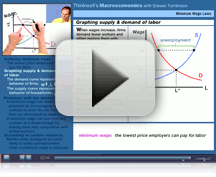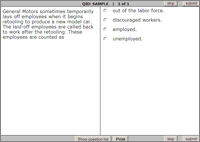Macroeconomics
Thinkwell's Macroeconomics is a one-semester college level course. Taught by acclaimed professor Steven Tomlinson, one of our country's most talented teachers, it's a great way to learn the economics of markets and countries, and how they interact. Used in conjunction with your college course, it's the study aid that will answer all of the questions your professor and textbook aren't answering. And because it's available 24/7 at one fixed price, not by the hour, it's better than a tutor.
Pairing Macroeconomics with its sister course, Microeconomics, comprises a one-year curriculum. Our Economics course is simply a combination of both Macroeconomics and Microeconomics.
Our complete Macroeconomics package includes:- 12-month Online Subscription to our complete Macroeconomics course with video lessons, automatically graded problems, and much more.
- Printed Notes (optional) are the Macroeconomics course notes from the Online Subscription printed in a black & white, on-the-go format. These are available for purchase from the Macroeconomics Course Site.
- CD Set (optional) contains all of the video lessons so that you can watch them when you're away from the internet.
Printed Notes and CD Sets require the purchase of an online subscription.
Money-Back Guarantee
Macroeconomics Materials
Online Subscription, 12-month access
Access to a complete online package that includes everything you need.
- Thinkwell's video lectures cover the comprehensive scope and sequence of topics covered in a college introductory macroeconomics course.
- Our automatically graded exercises with immediate feedback allow you to quickly determine which areas you'll need to spend extra time studying.
- Concise, illustrated review notes help you distill the fundamental ideas, concepts, and formulas you'll need to know in order to succeed.
- Subscriptions start when you are ready. Buy now and activate your course anytime you like. Wait up to one year to activate your subscription; your 12-month subscription doesn't begin until you say so!
CD Set Video Lectures on CD-ROM
This optional CD-ROM set delivers the exact same video lectures delivered online, but without an internet connection. Online Subscription is required; CDs not sold separately. The CDs only contain the videos.
Macroeconomics Details
Thinkwell's Macroeconomics includes:
- More than 260 topics with 300+ video lessons (see sample)
- 1000+ interactive economics exercises with immediate feedback allow you to track your progress
(see sample) - Printable illustrated notes for each topic
- Glossary of more than 450 economics terms
- Engaging content to help students advance their knowledge of economics:
- Supply, demand, equilibrium, and elasticity
- Consumer choice
- Production and costs
- Competitive markets and monopolies
- Measuring output, income, GDP, and cost of living
- Unemployment and inflation
- Aggregate expenditures
- Banking, spending, saving, and investing money
- Monetary and fiscal policy
- International economics
Table of Contents
(Expand All - Close All)1. Introduction to Economics
- 1.1 The Basics of Economics
- 1.1.1 Defining Economics
- 1.1.2 What Economists Do
- 1.1.3 Macroeconomics and Microeconomics
- 1.1.4 An Overview of Economic Systems
- 1.1.5 Case Study: The Work of Adam Smith
- 1.2 Graphs in Economics
- 1.2.1 Using Graphs to Understand Direct Relationships
- 1.2.2 Plotting a Linear Relationship between Two Variables
- 1.2.3 Changing the Intercept of a Linear Function
- 1.2.4 Understanding the Slope of a Linear Function
- 1.3 Demand
- 1.3.1 Determining the Components of Demand
- 1.3.2 Understanding the Basics of a Demand Curve
- 1.3.3 Analyzing Shifts in the Demand Curve
- 1.3.4 Understanding Changes in Other Demand Variables
- 1.3.5 Deriving a Market Demand Curve
- 1.4 Supply
- 1.4.1 Determining the Components of Supply
- 1.4.2 Deriving a Supply Curve
- 1.4.3 Understanding a Change in Supply versus a Change in Quantity Supplied
- 1.4.4 Analyzing Changes in Other Supply Variables
- 1.4.5 Deriving a Market Supply Curve
- 1.5 Competitive Equilibrium
- 1.5.1 Determining a Competitive Equilibrium
- 1.5.2 Defining Comparative Statics
- 1.5.3 Classifying Comparative Statics
- 1.6 Elasticity
- 1.6.1 Defining Elasticity
- 1.6.2 Calculating Elasticity
- 1.6.3 Applying the Concept of Elasticity
2. Macroeconomic Measurements
- 2.1 Aggregate Output and Income
- 2.1.1 The Production Possibilities Frontier: Macroeconomic Applications
- 2.1.2 The Circular Flow Model
- 2.1.3 Real GDP
- 2.1.4 The BEA Procedure for Calculating Real GDP
- 2.1.5 Limitations of GDP and Alternative Indexes
- 2.1.6 The Growth of China as a Superpower
- 2.2 Approaches to Calculating GDP
- 2.2.1 The Expenditures Approach
- 2.2.2 The Income Approach
- 2.3 Cost of Living
- 2.3.1 Changes in the Cost of Living and the CPI
- 2.3.2 Calculating the Rate of Inflation
- 2.3.3 Comparing the CPI and the GDP Deflator
- 2.3.4 Hot Topic: Income Distribution in the United States
3. Economic Fluctuations: Unemployment and Inflation
- 3.1 The Business Cycle
- 3.1.1 Recessions, Depressions, and Booms
- 3.1.2 Theoretical Explanations for Cycles
- 3.2 Measuring Unemployment
- 3.2.1 Measuring the Labor Force and Unemployment
- 3.2.2 Types of Unemployment
- 3.3 The Natural Rate of Unemployment
- 3.3.1 Understanding the Natural Rate of Unemployment
- 3.4 Causes of Unemployment
- 3.4.1 Minimum Wage Laws
- 3.4.2 An Analysis of Labor Unions and Unemployment
- 3.4.3 Case Study: "La Causa": The United Farm Workers
- 3.4.4 The Theory of Efficiency Wages
- 3.4.5 Unemployment Insurance
- 3.5 Inflation
- 3.5.1 Inflation, Deflation, Stagflation, and Hyperinflation
- 3.5.2 Inflation and Purchasing Power
- 3.5.3 Short-Run Causes: Demand-Pull and Cost-Push Inflation
- 3.5.4 The Quantity Theory of Money
- 3.5.5 The Costs of Inflation
- 3.5.6 Case Study: Behavior during Hyperinflation
4. Aggregate Expenditures Model
- 4.1 Historical Background
- 4.1.1 Say's Law and Keynes: An Overview
- 4.2 Components of Aggregate Expenditures
- 4.2.1 The Aggregate Expenditures Identity
- 4.2.2 Average and Marginal Propensities to Consume and Save
- 4.2.3 The Aggregate Expenditures Model
- 4.2.4 Case Study: The Paradox of Thrift
- 4.2.5 Autonomous Investment
- 4.3 Equilibrium GDP
- 4.3.1 The Expenditures Approach and the Savings Approach
- 4.4 The Multipliers
- 4.4.1 Applications of the Multipliers
- 4.5 Comparative Statics: The AE Model
- 4.5.1 Changes in Aggregate Expenditures
- 4.5.2 Changes in Taxes
- 4.5.3 Changes in Net Exports
- 4.5.4 Hot Topic: Does Social Security Need to Be "Saved"?
- 4.6 Keynes and the Aggregate Expenditures Model
- 4.6.1 Relating the Keynesian Model to the AD/AS Model
- 4.7 The Multipliers
- 4.7.1 Deriving the Multiplier
- 4.7.2 Case Study: The Paradox of Thrift
- 4.7.3 Hot Topic: Does Social Security Need to Be "Saved"?
5. Money: Banking, Spending, Saving, and Investing
- 5.1 Money in the Economy
- 5.1.1 The Money Supply
- 5.1.2 Determinants of Money Demand
- 5.1.3 The Money Market
- 5.2 Financial Markets
- 5.2.1 Financial Markets and Intermediaries
- 5.2.2 Stocks and Bonds
- 5.2.3 The Price of Bonds and the Interest Rate
- 5.3 The Fed
- 5.3.1 The Federal Reserve System
- 5.3.2 Hot Topic: Are Reserve Requirements Necessary?
- 5.3.3 The Fed's Tools of Monetary Policy
- 5.3.4 Case Study: The Greenspan Era
- 5.4 The Creation of Money
- 5.4.1 How Goldsmiths Created Money
- 5.4.2 Case Study: Cigarettes As Money
- 5.4.3 How Banks Create Money
- 5.4.4 How the Fed Changes the Money Supply
- 5.5 Saving and Investment
- 5.5.1 Investment Demand
- 5.5.2 The Market for Loanable Funds and Crowding Out
- 5.5.3 Equilibrium in the Money Market
6. Aggregate Demand/Aggregate Supply Model
- 6.1 Aggregate Demand
- 6.1.1 Deriving the Aggregate Demand Curve
- 6.1.2 Movement along the Aggregate Demand Curve
- 6.1.3 Shifts in Aggregate Demand
- 6.2 Aggregate Supply
- 6.2.1 The Short-Run Aggregate Supply Curve
- 6.2.2 The Labor Market
- 6.2.3 The Long-Run Aggregate Supply Curve
- 6.3 Differences in the Long Run and the Short Run
- 6.3.1 The Classical View
- 6.3.2 Equilibrium in the Short Run
- 6.3.3 Equilibrium in the Long Run
- 6.3.4 Expectations in the Long Run and the Short Run
- 6.3.5 Long-Run Macroeconomic Equilibrium
- 6.3.6 Case Study: The U.S. National Debt
- 6.3.7 Hot Topic: Oil Shocks
- 6.4 The Phillips Curve
- 6.4.1 Definitions and the Historical Record
- 6.4.2 Expectations and the Phillips Curve
7. Monetary and Fiscal Policy
- 7.1 Recessions and Booms
- 7.1.1 Unanticipated Changes in Aggregate Demand
- 7.1.2 Unanticipated Changes in Aggregate Supply
- 7.2 Fiscal Policy : The Mainstream
- 7.2.1 Fiscal Policy Using the AD/AS Model
- 7.2.2 The Market for Loanable Funds and Government Policy
- 7.2.3 Timing Problems and the AD/AS Model
- 7.2.4 Automatic Stabilizers
- 7.2.5 Hot Topic: The Political Business Cycle
- 7.3 Fiscal Policy: Alternative Approaches
- 7.3.1 New Keynesian and New Classical Approaches to Fiscal Policy
- 7.3.2 Supply-Side Policy
- 7.4 Monetary Policy: The Mainstream
- 7.4.1 The Quantity Theory of Money (review)
- 7.4.2 Monetary Policy Using the AD/AS Model
- 7.4.3 Monetary Responses to Changes in the Economy
- 7.4.4 Monetary Policy: Accommodation
- 7.4.5 Hot Topic: Should Monetary Policy Be Made by Rule or Discretion?
- 7.5 Monetary Policy: Alternative Approaches
- 7.5.1 New Keynesians versus Monetarists
- 7.5.2 New Classical Macroeconomics
- 7.5.3 Case Study: Policy in the Great Depression
8. Productivity and Growth
- 8.1 The Elements of Productivity and Growth
- 8.1.1 The Rule of 70, Compounding, and Growth
- 8.1.2 The PPF, the AD/AS Model, and Long-Run Growth
- 8.1.3 The Production Function and Growth
- 8.1.4 The Definition of Productivity and Factors Affecting It
- 8.2 Policy and Growth
- 8.2.1 Investment
- 8.2.2 Other Policies to Encourage Growth
- 8.2.3 Hot Topic: Women's Roles in Rural Economic Growth
- 8.3 Emerging Economies
- 8.3.1 Growth in Emerging Economies
- 8.3.2 Policies to Promote Growth
- 8.3.3 Hot Topic: The Myth of Exploding Populations
9. International Focus
- 9.1 Microeconomics Background
- 9.1.1 Determining the Difference between a Closed Economy and an Open Economy
- 9.1.2 Understanding Exports in an Open Economy
- 9.1.3 Analyzing a Change in Equilibrium in an Open Economy
- 9.1.4 Analyzing International Trade Using Comparative Advantage
- 9.2 Exports, Imports, and Accounting
- 9.2.1 The International Flow of Goods and Services
- 9.2.2 Balance of Payments
- 9.2.3 Balance of Payments: An Example
- 9.2.4 Trade Balances
- 9.3 Exchange Rates
- 9.3.1 Nominal Exchange Rates
- 9.3.2 Real Exchange Rates
- 9.3.3 Purchasing Power Parity
- 9.3.4 Determination of Exchange Rates
- 9.3.5 Floating and Fixed Systems
- 9.3.6 The Managed Float
- 9.4 Government Policies
- 9.4.1 Government Budget Deficits and Trade
- 9.4.2 Trade Policy
- 9.4.3 Hot Topic: Winners and Losers in NAFTA
- 9.4.4 Political Instability and Trade
- 9.4.5 Hot Topic: Is the World Trade Organization a Conspiracy?
- 9.5 Transition Economies
- 9.5.1 Centrally Planned Economies
- 9.5.2 Policies to Change to Market Systems
- 9.5.3 Comparative Economic Performance
About the Author

Sample Video Lessons

Sample Interactive Exercises


